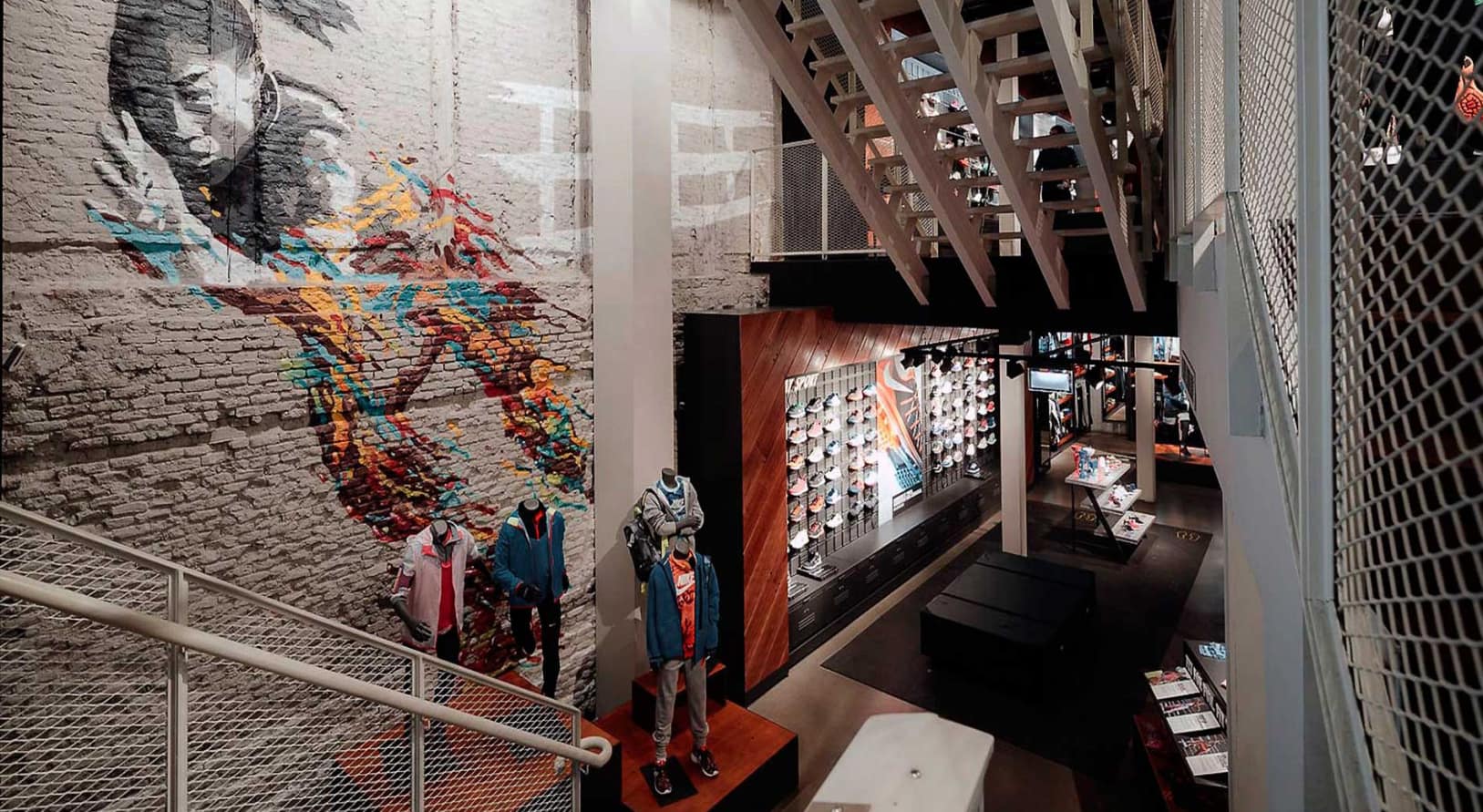
In the digital era, where e-commerce is continuously growing, commercial spaces must reinvent themselves to provide a unique and unforgettable customer experience.
When embarking on a new design project, key elements must be considered to create an attractive atmosphere aligned with your brand, aiming to boost sales.
“If there's a time your brand should prioritise space design and customer experience, it is now”
“Good design is not an expense, it’s your best investment”
Types of commercial spaces
Constructing commercial spaces involves balancing beauty, functionality, and habitability. Depending on the type of customers, products, and physical space size, these spaces can vary.
Wholesale Spaces act as intermediaries between manufacturers and customers:
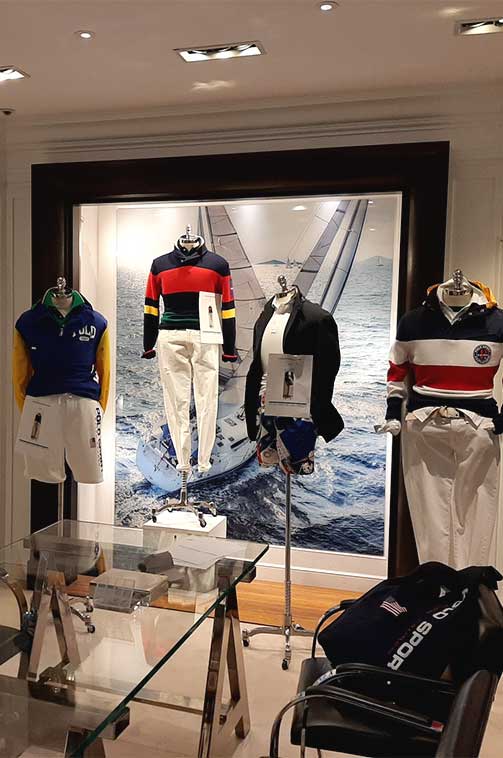
Graphic decoration of the Ralph Lauren Showroom in Madrid
Trade Fair Stands: Client engagement points at fairs, serving as strategic promotional tools for direct negotiations.
Retail Spaces sell directly to the final consumer:
“You never get a second chance to make a first impression”
Oscar Wilde’s quote perfectly highlights the importance of a commercial space’s exterior.
The facade is the brand’s communicator and differentiator. It creates the first impact that persuades customers to decide whether to enter. It reflects the personality and style of your business, indicating whether it caters to the passerby’s needs, setting you apart from competitors.
A key point in attracting customers is the access route. The entrance must not be a physical or visual barrier. Doors should be designed to be accessible and inviting. “The best entrance is one that doesn’t exist.”
Display window: the product’s introduction to the customer
“Nobody buys what they can’t see.” The display window introduces your product and must be given its deserved importance. It should grab attention, be distinctive, and remove the barrier between outside and inside. Product arrangement, volume creation, and decorative elements are key to crafting an engaging display that communicates your brand’s message, enticing customers to enter and purchase.
Signage: introduce your business to the customer
Having a sign that gives your business personality is essential. It should clearly identify what you do and make a memorable impression. Today, there are countless solutions: three-dimensional letters, illuminated signs, backlit signs, banners, etc. Effective signage enhances visibility and completes your brand image.
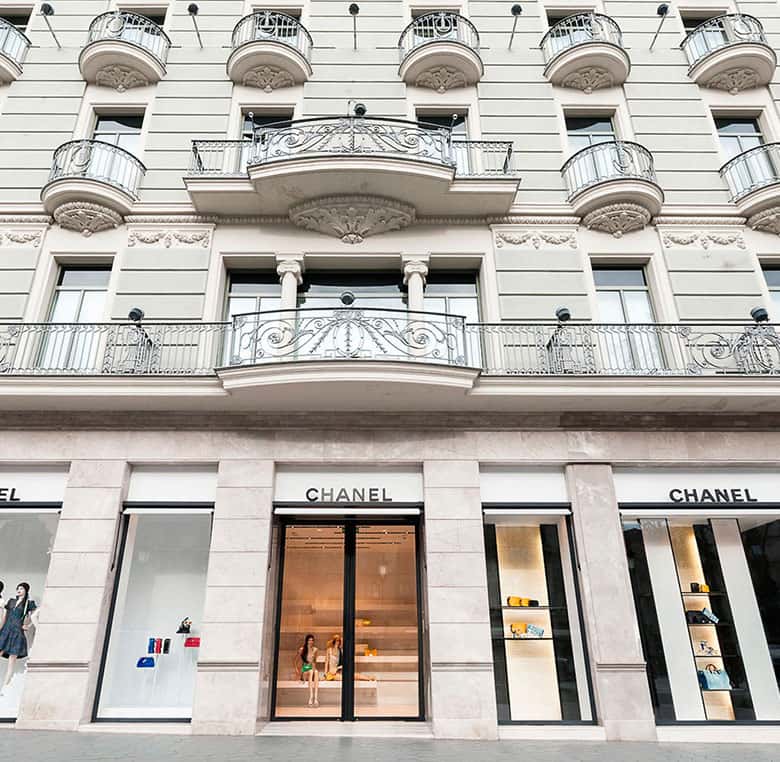
Window dressing for Chanel boutique in Madrid
Three-dimensional letters are increasingly popular for both exterior and interior signage.
They make your company’s name or slogan stand out with their size and illumination, always aligning with your business’s image.
This innovative signage attracts attention with its volume, design, and sometimes large size.
Cladding: Dress Your Surfaces
Besides providing an aesthetic that can differentiate and represent your brand, cladding is an excellent way to insulate, protect, and preserve the facade, which is prone to deterioration. Adding an additional material allows you to maintain the premises while adding style and personality.
Facade and display window vinyls also capture the attention of your target audience. They decorate, build customer trust, and increase interest in specific products.
Vinyls can be promotional, conveying offers and discounts, informative, helping customers understand and choose products, and decorative, reflecting the brand or specific product philosophy.
Similarly, vinyls can be used inside the store, placed on the floor of temporary promotional areas.
They are versatile and economical elements that help implement campaigns quickly, attractively, and ephemerally.
Facade Lighting: Attract New Customers
Lighting is another key point for the facade and display window, guiding the customer’s gaze where you want it. Products or communication elements highlighted by the brand should always be accompanied by light. It’s also important to ensure illumination during nighttime hours to continuously attract potential customers.
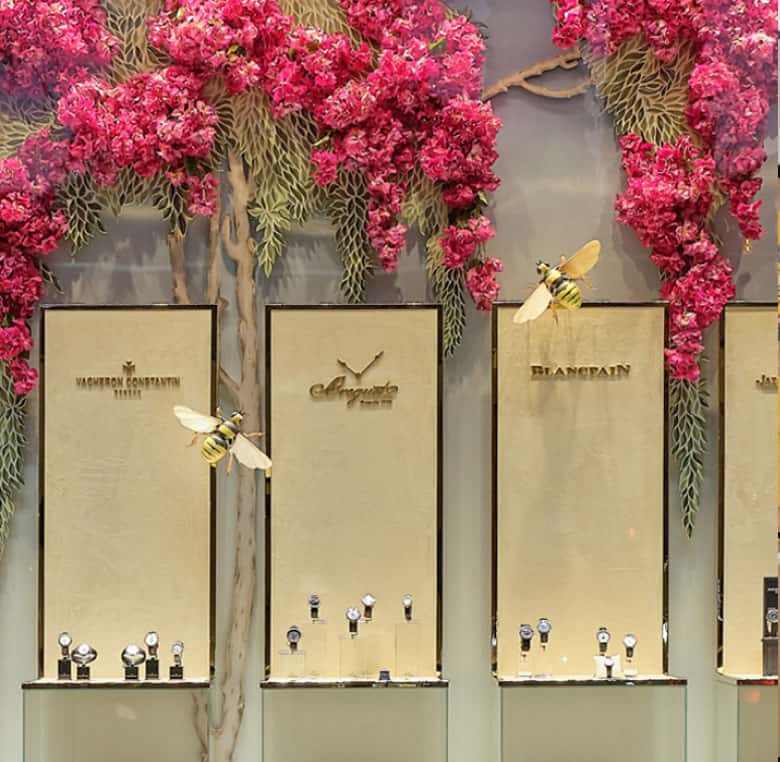
“The hidden ballet of Nature” RABAT window decoration in Madrid

Corporeal sign for Vodafone events
The interior of the store: your differentiator
While the exterior aesthetics of the premises are crucial, the interior decoration and layout are even more important. They should project your brand’s values and give visibility to the products and services you offer. Interior design transforms an ordinary space into a unique place.
In a competitive, tech-saturated world, the key to success is originality. You need to differentiate yourself by offering something new, distinct, and special.
Three important keys to creating a commercial space ambiance are:
1. Design with the competition in mind.
Avoid comparisons. Customers should feel identified with your brand, creating unique spaces and experiences they can’t find elsewhere, surprising and retaining buyers.
2. Design with the customer in mind.
This should be every business’s priority. Focus exclusively on customers, considering their tastes and needs, ensuring functionality so they can find exactly what they need.
3. Design respecting the brand/product philosophy.
Design should reflect the brand’s philosophy at every possible level: aesthetic, technological, and customer service.
"The purpose of commercial space design is to achieve a balance between aesthetic, functional, and structural aspects"
If you want to stand out and outpace your competitors, consider the following factors:
1. Space Layout in the Point of Sale
The aim is for customers to unconsciously navigate the maximum sales area, enhancing the purchase of all store products.
The access area is where customers first experience the interior ambiance, so it should be wide and obstacle-free, ideal for showcasing new or promotional items with an attractive display.
Product exposure extends beyond the display window into the store, where furniture plays a fundamental role in product presentation, space distribution, and circulation.
It is crucial to avoid creating bottlenecks. Design aisles wide enough for customers to comfortably spend time in your store.
The final purchase point, where customers complete their transactions, should include three elements: the till, a space for depositing selected products, and an area for additional items. This point should be highly visible, ideally at the end of the customer’s shopping journey.
Additionally, placing impulse purchase items or complementary products at the till can be beneficial.

Graphic installation for boutiques Emporio Armani Spain
2. Product Placement
It is proven that most consumers tend to move counterclockwise within a store. Thus, the entrance is usually on the right and the exit on the left. In this circuit, the entrance area is known as the “hot zone,” where products of interest should be placed for various reasons. The “cold zone,” the exit, should feature offers or eye-catching products to motivate return visits, as it is often overlooked.
Products should be grouped by category to simplify the customer’s search. Items at eye or hand level are more accessible.
The physical space occupied by products also significantly influences attention.
“Everything that is seen is picked up”. Attention must be paid to packaging, as it makes products appear larger and more eye-catching.
If we follow the idea that “mass promotes sales,” it can be beneficial for some businesses to display products in large quantities, giving a sense of abundance and importance, thus stimulating purchase. Conversely, if exclusivity is the goal, the product should be presented as a unique, select item.
“The sale of some products aids the sale of others” – high-selling products placed near low-selling ones can boost the latter’s sales, as can complementary products when placed together.
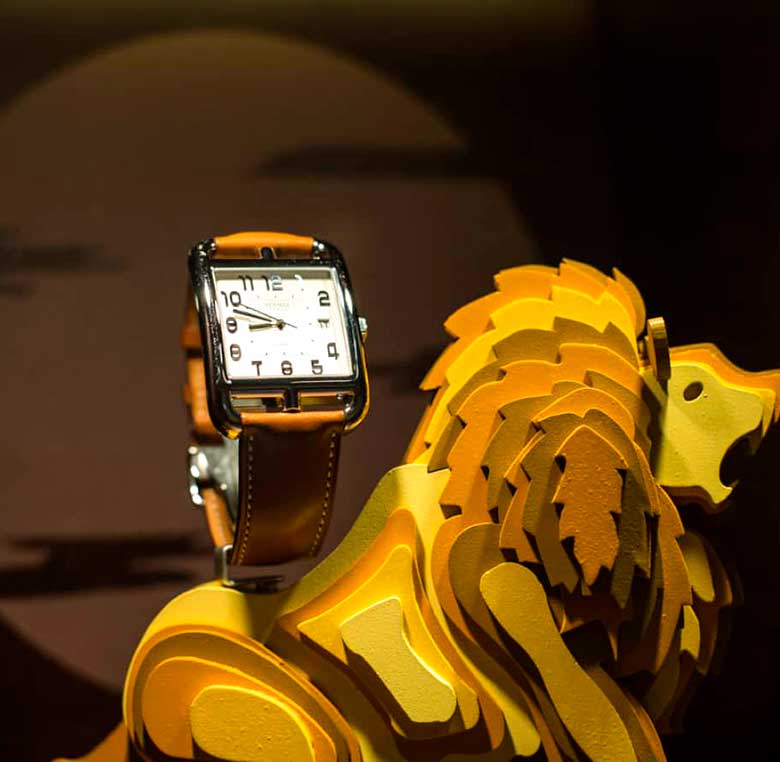
Jewelry display case detail of the Hermès Savanna Autumn windows

Nike Serrano Store, Madrid.
Comprehensive Decoration Nike Flyknit Lunar Project
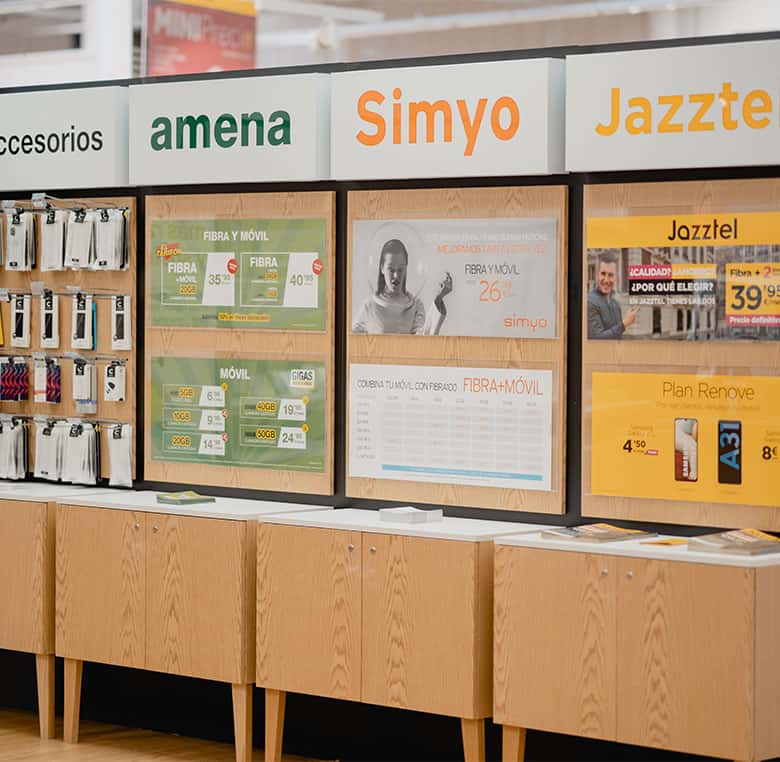
Production and installation of furniture for Orange stores in C.C. Carrefour
3. Furniture
Commercial furniture is a powerful element. It should facilitate customer access to products in a pleasant, practical, and visible manner, complementing the overall decor.
Furniture must harmonise with the space and integrate with the brand concept; otherwise, it won’t be effective. Ensure your furniture aligns with the space layout, and that colours and shapes evoke the desired sensations. Its primary objective is to display your product clearly and attractively.
4. Lighting
With lighting, ensure there are no dark areas in your store. Beyond that, use lighting to signal spaces effectively.
The better you manipulate light to focus on key areas or products, the more positive results you’ll achieve. Install small, strategically placed spotlights to help customers see products clearly and understand their value.
Proper lighting aids in the clear visualisation of colours, patterns, and shapes, guiding customers along the path you’ve designed through the arrangement of furniture and products.
5. Decoration
Decorative elements are crucial for creating the unique ambiance you desire. Plants, decorative vinyls, special displays, and varied furniture styles attract customers and make them feel comfortable in your store.
Other important elements include the store’s aroma, music, lighting, temperature, order, and cleanliness. All these should be in harmony with the brand image and essence of the business.
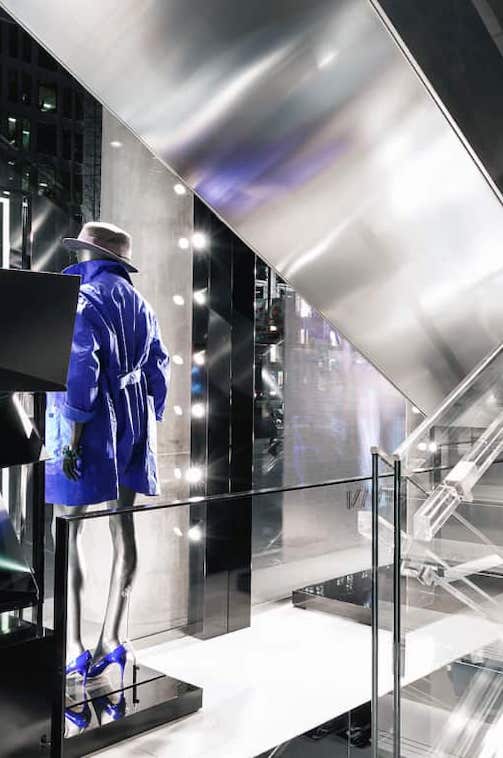
Emporio Armani boutique showcase in Madrid

Neon decoration for Nike Store
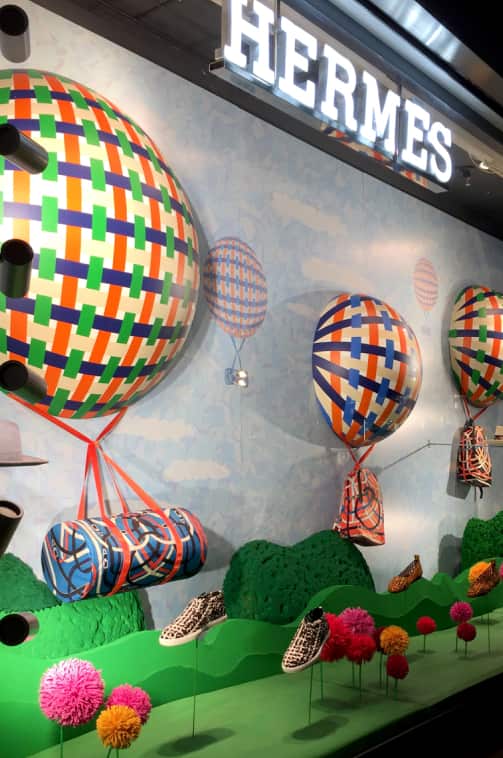
Hermés Tinkering Spain Shop Windows
6. Promotions
The importance of advertising and promotions at the point of sale is immense. It’s a marketing strategy that should not be overlooked.
You’ve likely seen large stores with brand logos on big posters or innovative designs to draw attention to certain products. The goal of point-of-sale advertising is to boost sales of specific items, increase purchase value, and enhance brand awareness.
Incorporating digital signage, audio point-of-sale materials, displays, and stands improves brand recognition and customer loyalty.
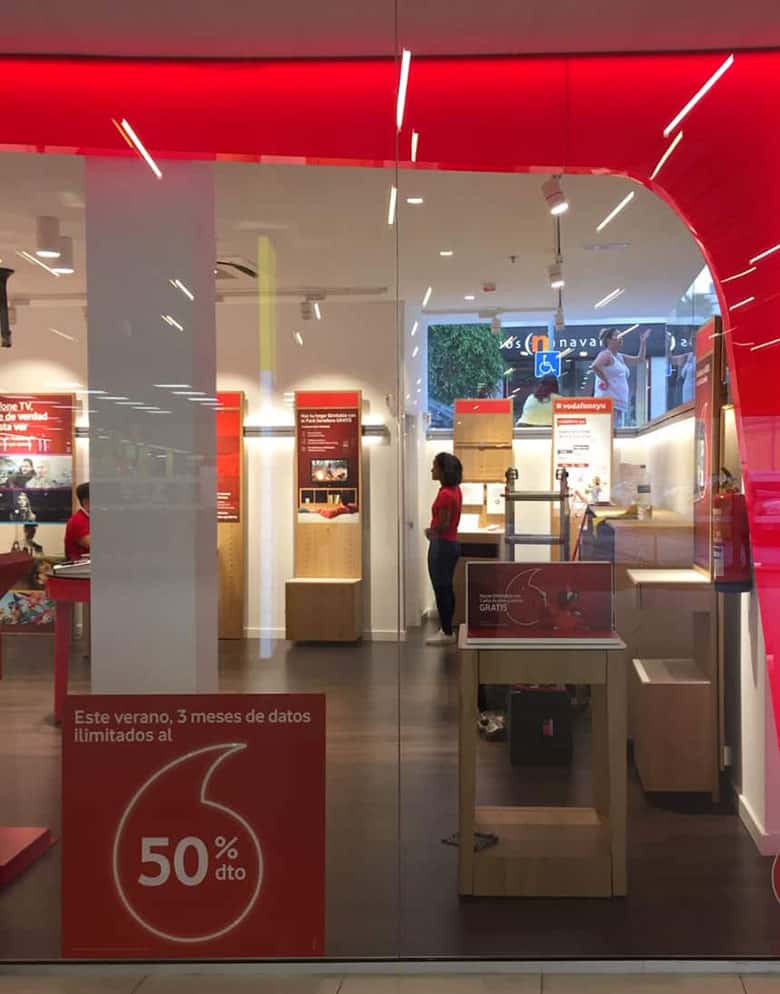
Graphic elements for Vodafone stores, example of POS.
Benefits of Point-of-Sale Advertising:
“The customer experience is key to attracting and retaining customers. It must be the centre of your strategy if you want to stay in the market.”
Modern consumers seek more than just products; they demand experiences. They desire not only rational satisfaction but also the joy and pleasure of the shopping experience.
To enhance this, create experiences that form emotional bonds with consumers, involving interactivity and immersion in your brand.
Understand your customer—where they come from, what they buy, what motivates them—to discover their needs and preferences. This is crucial for achieving customer loyalty.
“Acquiring a new customer is 7 times more expensive than retaining existing ones”
Brands should look for alternatives to traditional sales channels. By using elements such as music, scent, lighting, and visual merchandising, it is possible to influence customer purchase decisions, sometimes more effectively than with the product itself.
Some Tips to Improve Customer Experience
Use proper signage and layout: Ensure customers can easily find what they’re looking for, clearly see the offers, and navigate the store without issues.
Avoid queues: Have multiple single lines at checkouts and enhance waiting times with engaging app content. Place essential items, offers, and impulse buys at the tills.
Create an ideal atmosphere: Attractive, surprising, and functional decor and design are key to a positive customer experience and increased sales.
Create quality offers: Avoid low-quality flash deals that lead to buyer’s remorse. Ensure your offers add value.
Entertain: Some customers enjoy spending time in the store and savouring the shopping experience. It’s important to provide entertainment options to make their visit more enjoyable, such as interactive screens and attractive digital signage.
Offer impeccable customer service: Being polite isn’t enough. Add value for your customers by being approachable and professional, helping them with whatever they need, and making them feel unique.
Reward Loyalty: Reward your customers by inviting them to promotions or events, offering loyalty cards, sending coupons, or providing points for discounts to make them feel special.
People are predisposed to being pleasantly surprised by brands, so leveraging technology can set you apart from the competition. The shift in modern retail is clear: people seek more experiences and originality when choosing.
The Importance of Retail Design
After understanding these key points, the importance of retail design in our lives is evident. Now, only you can apply them to improve your business sales. The world is changing rapidly, and trends are evolving quickly. Retailers face different challenges every day. To stay ahead, invest in design, decoration, and technology in your commercial space. Offer something new and different, stand out in your sector, and you will achieve the success you desire.
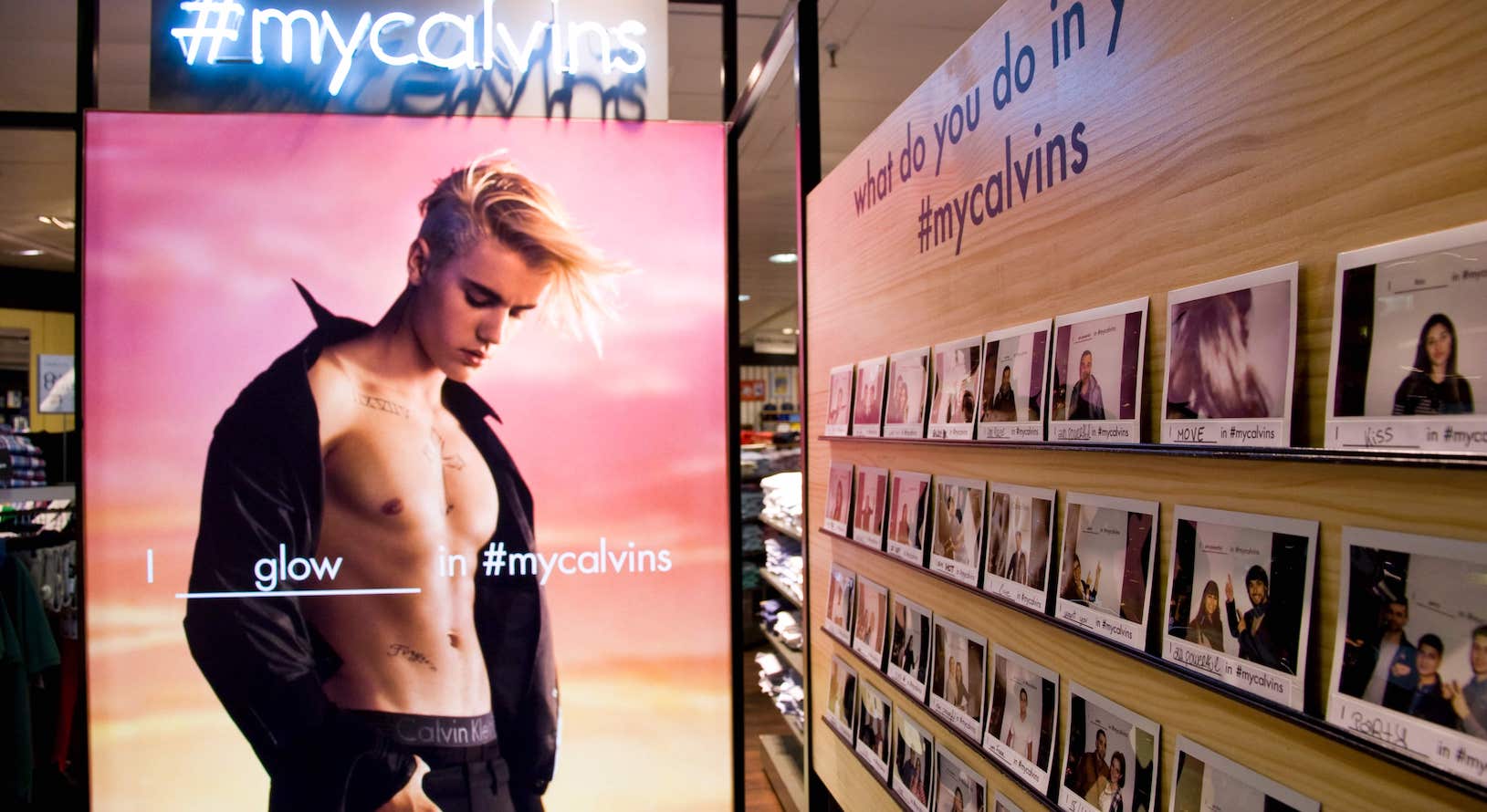
Pop Up Calvin Klein in El Corte Inglés #mycalvins campaign
You may also be interested
open
08:00 AM-18:00 PM Monday – Friday
08:00 AM-18:00 PM Monday – Friday